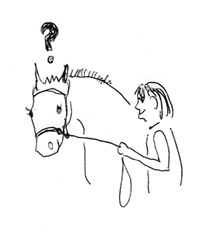Here are some tips for those who are interested in trying a bitless bridle of any kind….If you are switching from a bitted bridle to a bitless, first let me say congratulations! You are making a very important step in the right direction of improving your horse’s health and happiness!
Okay so, here is how to start:
1. Begin on the ground, standing next to your horse, with either a halter or bitless bridle on your horse.
2. Stand at your horse’s side, at about the shoulder, and pick up the rein (or leadrope.. I’ll just call it rein from now on, but it can mean either) until you are pulling slightly on your horse’s head. Keep the pressure soft but firm, and consistent.
3. When the horse starts to feel the pressure (or starts to want to do something about it) he will begin to move his head, either up, down sideways, etc. At first, he will not know what you are asking him to do.

At this point (this is important) keep the pressure the same until he tries moving his head towards you, even the tiniest little bit. Immediately release the pressure, and wait 5-10 seconds doing nothing. (This tells him he has picked the right answer).

4. Pick up the rein again, and put the same gently but consistent pressure. This time the horse may move towards you right away. For even the smallest try (toward you), immediately release the pressure, and wait 5-10 seconds.
5. Pick up the rein and ask for him to bring his head a bit closer, by holding the pressure just a bit longer till he moves it towards you. Repeat this process until the horse is bringing his head all the way to you (at his shoulder) with light pressure.
6. Now do it on the other side. (Horse’s don’t extrapolate information from one side to the other, you have to practice everything on both sides!)
7. Now you’re going to do the same thing from in the saddle. Start by just standing still. Gently pull one rein towards your knee, and wait for the response. Timing is everything, so immediately release when you get a try. Keep doing this till his head comes all the way around to your knee with light pressure. Do this on both sides.
8. Now practice this at the walk, then the trot, and then the canter (although his head won’t be able to come all the way to your knee really, but you get the idea).
Now, not only have you built a solid introduction to the bitless bridle, but you have accomplished several other things as well: Your horse is now soft and responsive to your hand, and, you have just built the foundation for the calm down cue, and the emergency stop cue.
The calm down cue is anything you do to help you horse to calm down when he is nervous, or about to become nervous. For example, if he always spooks when you pass the mailbox (trash can, tractor, whatever), start asking him for his head (bending towards you) as you approach the scary item. You will find that his mind is more on you than on the item, which he may ignore completely. If he does spook, then do 3 small circles right there, immediately after the spook. Every time he spooks, do these 3 small circles. Keep in mind that the horse must pair the spook with the circles. Don’t do the circles until he has actually spooked. If you do the circles before he has spooked, you are essentially ‘correcting’ something he hasn’t even done yet. Eventually your horse will see the scary item, and say “Gosh, I really don’t want to have to do all those silly circles….. I think I’ll just ignore that trash can today.
“Be careful not to anticipate a spook. If you know your horse always spooks at the mailbox, TRY VERY HARD to keep your body relaxed and balanced as he approaches. If you get nervous and tense, then so will he. Give him the opportunity to be good first, only correct after a spook. Some people have inadvertently taught their horse to spook by getting nervous themselves first, which sends a signal to your horse that ‘this is something to be afraid of,’ which will reinforce any tendency to spook at that item.
You also now have your emergency stop cue in place. If your horse starts to run away with you, don’t panic. Reach down and pull one rein around to your knee. If you have done all the prep work, he will bring his head around, and will thereby have to slow down. It is very very hard for a horse to run away with his head tucked around to your knee (although not impossible!). It is a good idea to practice this at the canter (simulating a running away scenario) first, so that he is familiar with doing it at speed. And remember, as always, the more you practice, the better he’ll be!
Filed under: Uncategorized | Tagged: bitless bridle, calm down cue, de-spooking, horse, horses, how to use a bitless bridle, natural horsemanship, training | 3 Comments »





